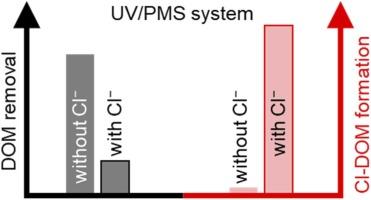高浓度Cl -对UV/PMS系统转化垃圾渗滤液DOM的影响——以苏万尼河天然有机物(SRNOM)为模拟物的垃圾渗滤液DOM机理研究
IF 11.3
1区 环境科学与生态学
Q1 ENGINEERING, ENVIRONMENTAL
引用次数: 0
摘要
紫外活化过氧膦酸盐系统(UV/PMS)是一种去除废水中溶解性有机物(DOM)的有效高级氧化工艺,但垃圾渗滤液中氯离子(Cl−)浓度过高,限制了该工艺的发展。本研究采用傅里叶变换离子回旋共振质谱法研究了高Cl−存在下DOM与UV/PMS的反应。结果表明,当浓度为10,000 mg/L Cl−时,高浓度Cl−会产生氯自由基、二氯自由基和次氯酸/次氯酸盐等活性氯物质,使苏万尼河天然有机物(SRNOM)的总有机碳(TOC)去除率从79%降至39%。在没有Cl -的情况下,UV/PMS过程从SRNOM中去除几乎所有的分子种类,并生成低氧含量的脂肪族物质。当存在高浓度Cl−时,它优先去除芳香和高度不饱和分子,并产生408种未知的氯化dom,这些dom具有高度不饱和和高氧含量的特征,包括CHOCl、CHONCl和CHOSCl。我们发现,在不含Cl−的UV/PMS过程中,DOM主要通过脱烷基、脱羧和去芳构化降解;高浓度的Cl−破坏了这些反应,氯化DOM通过氯的加成/取代和其他氧化反应形成。本文章由计算机程序翻译,如有差异,请以英文原文为准。

Effect of a high Cl– concentration on the transformation of waste leachate DOM by the UV/PMS system: A mechanistic study using the Suwannee River natural organic matter (SRNOM) as a simulator of waste leachate DOM
The ultraviolet-activated peroxymosnofulate (UV/PMS) system, an effective advanced oxidation process for removing dissolved organic matter (DOM) from wastewater, is limited by high chloride ion (Cl−) concentrations in landfill leachate. This study used Fourier transform ion cyclotron resonance mass spectrometry to explore the transformation of DOM in the UV/PMS system with a high Cl− concentration. The results revealed that elevated Cl− levels generate reactive chlorine species, including chlorine radicals, dichlorine radicals, and hypochlorous acid/hypochlorite, reducing the total organic carbon (TOC) removal efficiency of Suwannee River natural organic matter (SRNOM) from 78.9 % to 39.3 % at 10,000 mg/L Cl−, 0.5 mM PMS, and 60 min. In the absence of Cl–, the UV/PMS system removes almost all molecular species from SRNOM and generates aliphatic substances with low oxygen contents. When high concentrations of Cl− are present, it preferentially removes aromatic and highly unsaturated molecules and produces 408 unknown chlorinated DOMs with highly unsaturated and high-oxygen content features, including CHOCl, CHONCl, and CHOSCl species. We find that in the UV/PMS system without Cl−, DOM is degraded primarily by dealkylation, decarboxylation, hydrogenation, and dearomatization; high concentrations of Cl− impair these reactions, and chlorinated DOM forms via chlorine addition/substitution along with other oxidative reactions.
求助全文
通过发布文献求助,成功后即可免费获取论文全文。
去求助
来源期刊

Journal of Hazardous Materials
工程技术-工程:环境
CiteScore
25.40
自引率
5.90%
发文量
3059
审稿时长
58 days
期刊介绍:
The Journal of Hazardous Materials serves as a global platform for promoting cutting-edge research in the field of Environmental Science and Engineering. Our publication features a wide range of articles, including full-length research papers, review articles, and perspectives, with the aim of enhancing our understanding of the dangers and risks associated with various materials concerning public health and the environment. It is important to note that the term "environmental contaminants" refers specifically to substances that pose hazardous effects through contamination, while excluding those that do not have such impacts on the environment or human health. Moreover, we emphasize the distinction between wastes and hazardous materials in order to provide further clarity on the scope of the journal. We have a keen interest in exploring specific compounds and microbial agents that have adverse effects on the environment.
 求助内容:
求助内容: 应助结果提醒方式:
应助结果提醒方式:


